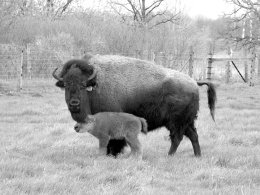 |
|
Prairie Home Companions
by Elizabeth Clements
In 1974, a biologist, Robert Betz, initiated the Fermilab prairie reconstruction project with a vision to reconstruct a large-scale prairie on portions of Fermilab’s land. Fermilab’s Founding Director, Robert R. Wilson, supported the idea, and the project was born. This year, with 6,800 acres of land, 273 species of birds, 53 species of butterflies, 32 bison (and a partridge in a pear tree?), the Fermilab prairie reconstruction project celebrates its twenty-eighth birthday. And from Henslow’s Sparrows to Silver-bordered Fritillaries, the Fermilab prairie certainly has some achievements to raise a glass to this year. Fermilab’s Roads and Grounds Department hosted two successful prairie harvests this fall, with approximately 240 people attending the events. Roads and Grounds also conducted controlled prairie burns in the spring and fall, burning approximately 700 acres of prairie land, to eradicate weedy, non-native plants and to help native seeds grow.
Dave Shemanske of Roads and Grounds explained that before conducting a prairie burn, many precautions must be taken to make sure that the wind is blowing at the right speed and in the right direction. “Prairie burns require extensive planning and good communication. The whole crew works as a team,” Shemanske said.“We burn only when the weather and wind offer us a window of opportunity.” One of the best measures of the quality of Fermilab’s prairie land is how many rare animal species call it home. This year’s large increase in Henslow’s Sparrows, a state-designated endangered bird that is extremely fussy about its habitat, indicates that the grasslands at Fermilab are of the highest quality. According to Peter Kasper, a Fermilab physicist and local bird expert, 2002 was the best year for Henslow’s Sparrows at Fermilab. This past summer, large numbers of the bird were found inside the main ring for the first time and in the grasslands along Eola Road, which have been specifically managed to attract Henslow’s Sparrows. Kasper explained that a prairie is considered to have excellent grasslands if Henslow’s Sparrows decide to inhabit them. “If you have Henslow’s, you must be doing something right.” Kasper said. For birders, “Henslow’s sparrows are the most interesting thing of the year.”
For butterfly experts, the Silver-bordered Fritillary, a very rare butterfly in the Illinois region, is the story of the year. On October 2, Doug Taron, the Curator of Biology at Chicago’s Peggy Notebaert Nature Museum, released 40 Silver-bordered Fritillary caterpillars into the fields to the east of the Fermilab Village, with the help of Tom Peterson, a Fermilab engineer and butterfly expert, and Bob Lootens of Fermilab’s Roads & Grounds Department [FERMINEWS — November 1,2002]. They hope that by next spring, these 40 caterpillars will grow into adult butterflies and spawn a new colony of Silver-bordered Fritillaries in the Fermilab prairie. Although many new plants have been introduced to the prairie, Lootens believes that the Silver- bordered Fritillary may be the first new animal introduced to Fermilab. This groundbreaking introduction of a species brings the Prairie Reconstruction Project one step closer to being complete. Peterson reports that the Fermilab butterfly list also may be close to being complete. No new butterfly populations were found this year, but the ones that were previously seen, such as the Clouded Sulphur and Dion Skipper, are still “thriving and active ”. “Not seeing a new species indicates that we have a fairly mature list that is close to being complete,” Peterson said.“I am interested in long term monitoring of butterflies. Hopefully twenty years from now, people can use our list as a baseline to see how things have changed.” A prairie cannot be considered complete without a few bison roaming around. Fermilab’s legendary herd of bison currently has twenty-nine cows and three bulls. The herd reached its peak number this past spring, when over two-dozen calves were born. In October, twenty-five calves and three cows were sold to private bidders. John Plese of Roads and Grounds expects the herd to return to its normal size of about sixty bison after babies are born in the spring of 2003. “The buffalo are doing very well. Everyone here takes very good care of them,” Plese said.“People drive here all the way from other states just to see the buffalo at Fermilab.” They are witnesses to the prairie legacy founded by Wilson and Betz.
|


